Reviewed by Glenn Erickson
Warner Home Video continues its commitment to Blu-ray methodically releasing selected restored titles to disc. The Warner / Turner digital works over in Burbank is never idle, with dozens of restoration projects in progress at any one time. We know this because the results often show up on the Turner Classic Movie Channel. When some old favorite suddenly looks like it was filmed yesterday, minus scratches and flicker and hiss on the soundtrack, it's a special thing indeed. Put back into primo condition, the musical classic 42nd Street is once again a true knockout, especially for someone who remembers it as a terrible-looking 16mm print at UCLA, back in the stone age.
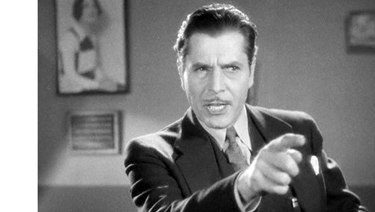
This one production reportedly saved the musical from extinction, as the genre had dried up around 1931 after a tired succession of operettas and stage revues filmed with little or no imagination: take a look sometime at the grotesque Golden Dawn, which seeks to 'open up' what must be the most politically incorrect musical of all time. Eddie Cantor's pictures were star vehicles, and there were terrific experiments from people like Ernst Lubitsch, but this is the full-bore Broadway-style musical comedy that broke through. The snappy pop music and the visual fireworks of Busby Berkeley's fantastic musical numbers was for a couple of years considered the height of Hollywood glamour. Those elaborate stagecraft stories that couldn't happen on any real stage were a powerful mix of romance, glitz and youthful sex.
42nd Street isn't the first puttin'-on-a-show backstage Broadway spectacle but it's the one that's became the archetype. Gold-digging chorus girls, goggle-eyed sugar daddies, old pros and young hopefuls are all here, as is the notion that an eager understudy might be given her big break, should the star be so obliging as to break her leg. The cornball plot is compelling because the 'young and healthy' cast believes in it so strongly; Al Dubin and Harry Warren's songs have an aggressive, Depression-era immediacy.
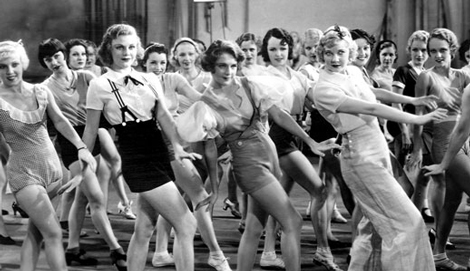
Broadway legend Julian Marsh (Warner Baxter) signs to direct the musical comedy "Pretty Lady" despite suffering from a heart condition. Rehearsals are rocky at best, as the infantile producer Abner Dillon (Guy Kibbee) has the illusion that leading lady Dorothy Brock (Bebe Daniels) is in love with him. She's really in love with an old vaudeville partner, Pat Denning (George Brent). Green chorus girl Peggy Sawyer (Ruby Keeler) meets juvenile Billy Lawler (Dick Powell) and is shown the ropes by chorines Lorraine Fleming and Anytime Annie (Una Merkel and Ginger Rogers). "Pretty Lady" is barely limping to its out-of-town trial in Philadelphia when Dorothy Brock breaks her ankle. Who will go on in her place?
The Great Depression is behind every scene of 42nd Street. Although not as nervous about breadlines and defaulting on the rent as the later Golddiggers of 1933, does have a definite hangdog attitude. Ex-vaudeville performer Pat Denning is a nice guy out of work, who fears that he'll become a kept man. Star director Julian Marsh lost his shirt in the Wall Street Crash. With his bad ticker, he knows he might die struggling to get the show on its feet. Even though the play is a triumph, the movie ends on a somber note of exhaustion.
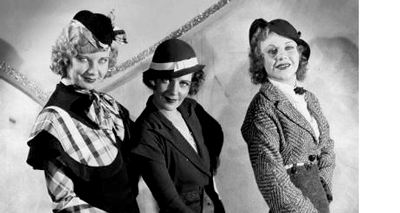
Warner Baxter plays the role as high drama, as if impervious to the fun and jokes elsewhere. His famous backstage coaching to Peggy Sawyer is supposed to calm her down, but is so emphatically frantic that it would put anybody in a nervous panic:
"You've got to go on, and you've got to give and give and give. They've got to like you. Got to. Do you understand? You can't fall down. You can't because your future's in it, my future and everything all of us have is staked on you. All right, now I'm through, but you keep your feet on the ground and your head on those shoulders of yours and go out, and Sawyer, you're going out a youngster but you've got to come back a star!'"
The rest of the cast is a delightful mix of backstage attitudes. We once laughed at Ruby Keeler, but she is supposed to be playing an innocent newcomer. Dick Powell is suitably goofy yet has a much better presence than the usual grinning clod with slicked back hair that passes for the young lead in these things. Comparing Powell to his later tough-guy roles in films noirs like Pitfall, is an object lesson in the souring/maturing of the American outlook. Ginger Rogers and Una Merkel's Lorraine and Anytime Annie are smart girls who know their way around an off-color joke. Bebe Daniels makes the unhappy Dorothy Brock into a solid character. Her presence in the great pep talk scene is such that Keeler's Peggy barely registers.
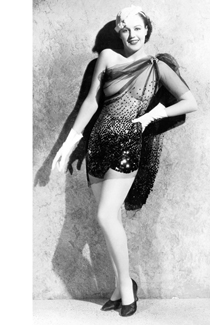
Broadway is used as a metaphor for the spirit that makes America great. Some of the management decisions are unjust (Abner Dillon expecting favors for his money) or crooked (Pat Denning threatened by gangsters). But down in the trenches, the hard-working performers rehearse their hearts out to please Julian Marsh and produce something great. Sassy Lorraine and Anytime Annie trade smart one-liners. Annie puts on a cynical front, yet when push comes to shove is a 'real trouper', a believer that the show must go on.
The Busby Berkeley musicals made in the pre-Code years practically thumb their noses at the puritanical censorship code. There are jokes about prostitution, about women being kept by wealthy men or trading for favors to get parts. A certain level of promiscuity is treated as normal. The costumes are skimpy and undergarments seem to be optional. The showgirls don't dress as provocatively as they do in some of the publicity photos, but there is a constant tease of nudity.
42nd Street's leading romantic ballad ("You're Getting to be a Habit with Me") compares romance with graphic descriptions of drug addiction. The finale representing the big premiere features three killer Busby Berkeley numbers. The cutesy novelty song Shuffle off to Buffalo insinuates and anticipates all kinds of honeymoon hanky-panky. Clarence Nordstrom and Ruby Keeler trot down a sleeper car that conveniently splits in half, while Una Merkel and Ginger Rogers heckle them from the top berth. The mechanical train is only a slight exaggeration of what might be presented on a Broadway stage. Topical references crop up in these 1933-era lyrics, and also different attitudes to certain words. The word 'belly' was considered vulgar at the time, so in Shuffle Off to Buffalo" Ginger Rogers stumble-substitutes 'tummy'. Then there is the lyric,
"Someday, I hope we'll be elected / to buy a lot of baby clothes
We won't know when we'll expect it / But I'm sure Winchell knows."
With the old unclear soundtrack, I could never properly make out the word "Winchell." Now it's clear that it refers to the Broadway columnist Walter Winchell, who had the reputation of getting the hot gossip on everyone in town.

Young and Healthy is the choreographer's first 'geometric' dance, using a platoon of chorus girls on revolving circular platforms. At one point the camera cuts to a 'straight down' high angle, and the dancers suddenly become abstract shapes, forming and re-forming into different architectural patterns. Dick Powell serenades beauty Toby Wing, a poised platinum blonde with a patented frozen Busby Berkeley smile. He ends up grinning at her side, framed in an archway formed by the legs of a dozen shapely chorines. The lyrics state the message loud and clear: let's have sex while the sun shines:
"If I could hate you / I'd keep away
But it ain't my nature, I'm filled with Vitamin A -- WHOAH- OH- OH!"
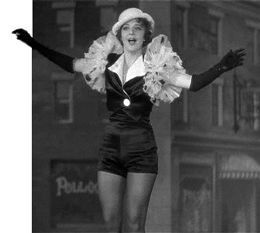
Finally there comes the big number 42nd Street. Keeler does her famous tap (clog?) dance atop a taxicab for the big title tune. We used to laugh at this as well, but in reality Keeler was a respected expert in a kind of tap that concentrates not as much on how things look but the tapping itself. The taps are as clear as a drummer's. I believe I heard that in a filmed interview with James Cagney. The 42nd Street number is Berkeley's first in which the stage opens into a complex super-theatrical set piece. Citizens in a rough neighborhood nod and rock to the music like the animated creatures of 'Toontown' as they perform 'a rhapsody of laughter and tears.' Domestic violence in an upstairs apartment leads to gunfire and a spectacular second floor swan dive escape. Then the screen fills with dancers for the big finish. The song 42nd Street is a snappy streetwise original, like all of the Warren-Dubin hit tunes. These depression-era songs always have an immediate emotional hook, with strong melodies. They fight for our attention, as if failure meant ending up in a breadline. In the spirit of the time, the message seems to be, 'we're gonna entertain you! You're going to love us whether you like it or not.'

The Warner Archive Collection Blu-ray of 42nd Street is great entertainment in a quality package. The restoration puts a polish on the B&W image, reproducing the old Warner Bros. silver-screen appearance. If you haven't seen this one in the last five years, I guarantee that you'll notice the improvement.
Warners throws a lot of extra content our way, all recycled from the DVD era. Besides a making-of featurette there's another celebrating songwriter-composer Harry Warren, and a vintage short subject taking a backstage look at Busby Berkeley in action. Two 'Merrie Melodies' cartoons come off as music videos for the songs Shuffle Off to Buffalo and Young and Healthy -- completely cleaned up, of course. Newsreel coverage of a promotional junket shows various Warners stars on the train, including Joe E. Brown, Tom Mix and his horse, Bette Davis, and Glenda Farrell.
I only wish Warners had included a comparison sample of the contrasty, muffled 16mm prints of 42nd Street that were once the norm. Only now are viewers able to look at these 80 year-old movies and not think of them as dusty fossils. In the grim year of 1933 shows like this still must have been the height of glamour - and the women the most exciting creatures in the world.

On a scale of Excellent, Good, Fair, and Poor,
42nd Street Blu-ray rates:
Movie: Excellent
Video: Excellent
Sound: Excellent
Supplements: Featurettes Harry Warren: America's Foremost Composer; A Trip Through a Hollywood Studio and From Book to Screen to Stage. Newsreel about all-star train promotion; Cartoons Shuffle Off to Buffalo and Young and Healthy.
Deaf and Hearing Impaired Friendly?
YES; Subtitles: English
Packaging: Keep case
Reviewed: April 17, 2015

Text © Copyright 2015 Glenn Erickson
See more exclusive reviews on the Savant Main Page.
Reviews on the Savant main site have additional credits information and are often updated and annotated with reader input and graphics.
T'was Ever Thus.
Return to Top of Page
|


